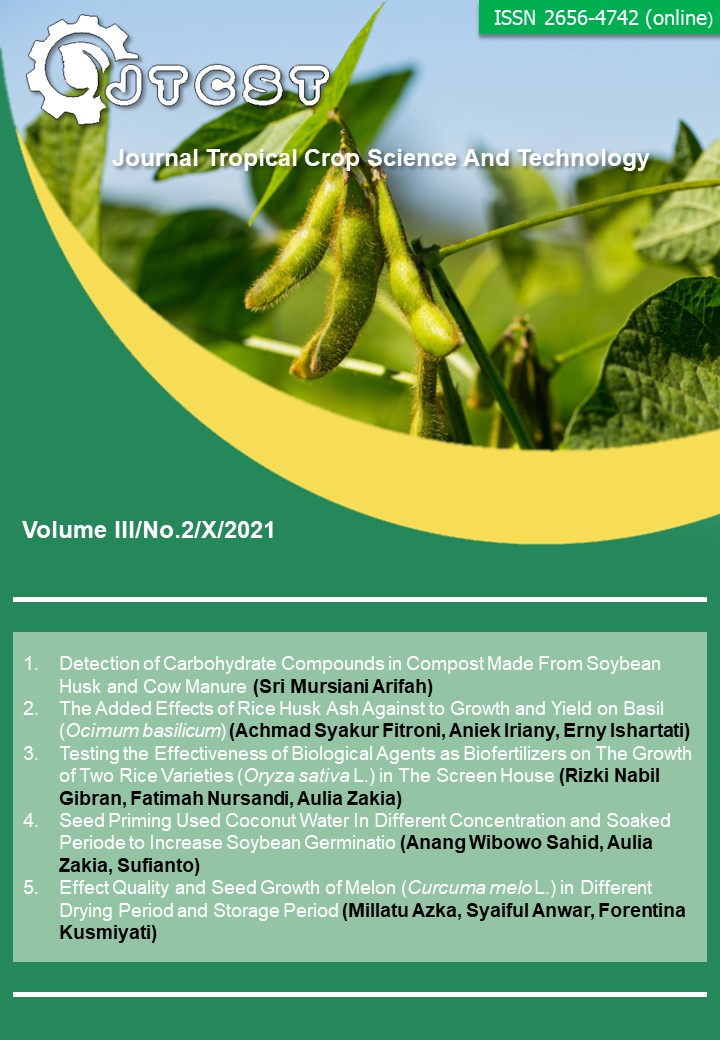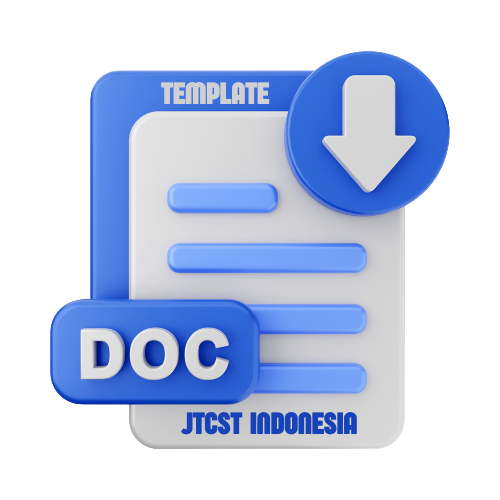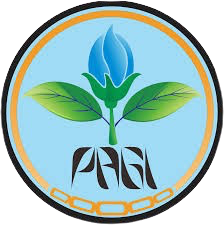Testing the Effectiveness of Biological Agents as Biofertilizers on the Growth of Two Rice Varieties (Oryza sativa L.) in Screen House
DOI:
https://doi.org/10.22219/jtcst.v3i2.29743Keywords:
Biofertilizer, Ciherang Variety, IR64 VarietyAbstract
Rice (Oryza sativa L.) is one of the most important food commodities for human nutritional needs. The amount of rice consumption per capita per week in 2017 was 1,571 (BPS, 2018). Population growth over time has resulted in increased demand for rice in Indonesia. Therefore, the demand for rice by the Indonesian people is very high. The problem is that the demand for local rice in Indonesia is still low, so one way to meet the demand for rice in Indonesia is through imports. Utilization of water and land resources is one of the common challenges faced in realizing national food security (Fita et al., 2013). Low productivity of rice plants is generally caused by biological, physical, and chemical soil problems. One of the efforts to increase the productivity of rice plants is by utilizing biological resources such as biofertilizers.The objectives of this study were to determine the appropriate dose of biofertilizer that will affect the growth of rice plants, determine the combination of biofertilizer and application interval that affects the growth of rice plants, and determine the effect of biofertilizer application on 2 varieties of rice plants (Ciherang and IR 64). The design used in this study was a factorial complete randomized block design (RKLT) to determine the interaction and effect of each factor. Then DMRT (Duncan's test) was conducted to determine the best treatment. Based on the results of the study, it was found that the interaction between biofertilizer treatment and rice varieties had significant effects on almost all observed variables except stem diameter at 70 HST, number of clumps at 42 HST, number of productive tillers, and weight of planted seeds. The combination of biofertilizer treatment and rice variety had inconsistent effects on growth parameters and rice yield.
Downloads
References
Agus, S., Minarsih, S., Prayudi, B., Efektivitas Pemberian Pupuk Hayati Terhadap Pertumbuhan Dan Hasil Padi Gogo Pada Tanah Kering. Jurnal Agritech. 16(1) : 1-12
Asroh, A. 2010. Pengaruh Takaran Pupuk Kandang dan Interval Pemberian Pupuk Hayati Terhadap Pertumbuhan dan Hasil Tanaman Jagung Manis (Zea Mays Saccharata Linn). Agonobis. 2(4) : 1 - 6
Bakhtiar. Kesumawati, E., Hidayat, T., dan Rahmawati, M. 2011. Karakterisasi Plasma Nutfah Padi Lokal Aceh Untuk Perakitan Varietas Adaptif Pada Tanah Masam. Jurnal Agista.15 (3) : 79 - 86
Bachtiar. T., Waluyu. S. H, Syaukat. S. H. 2013. Pengaruh Pupuk Kandang Dan SP-36 Terhadap Pertumbuhan Tanaman Padi Sawah. Jurnal Ilmiah Aplikasi Isotop Dan Radiasi. 2(9) : 151-159.
Bakhtiar., Kesumawati, E., Hidayat, T., dan Rahmawati, M. 2011. Karakterisasi Plasma Nutfah Padi Lokal Aceh Untuk Perakitan Varietas Adaptif Pada Tanah Masam. Jurnal Agista. 15 (3) : 79 - 86
Fita. A., Agus. S, Nurul. A, 2013. Sistem Tanam Dan Umur Bibit Pada Tanaman Padi Sawah (Oryza Sativa. L) Varietas Inpari 13. Jurnal Produksi Tanaman. 2(1) : 52-60
Fitriatin. N. B., Nabila. E. M., Turmuktini. T., Sofyan. T. E. 2019. Kontribusi Pupuk Hayati dan Pupuk Anorganik Untuk Meningkatkan Pertumbuhan dan Hasil Tanaman Padi Gogo Di Ultisols Jatinangor.
Hartanto. M., Melati. M. 2013. Budidaya Padi Organik Dengan Waktu Aplikasi Pupuk Kandang Yang Berbeda Dengan Pemberian Pupuk Hayati. Agohorti. 1(4) : 9-17
Ida. S. R. 2013. Manfaat Penggunaan Pupuk Organik Untuk Kesuburan Tanah. Jurnal Universitas Tulungagung Bonorowo. 1(1) : 30-42
Lang Lang Dewi. P. N. 2017. Pemanfaatan Teknik Rapd Dalam Deteksi Keragaman Genetik Padi (Oryza Sativa L.) Varietas Bahbutong Tahan Cekaman Kekeringan Hasil Iradiasi. Skripsi. Departemen Biologi Fakultas Matematika Dan Ilmu Pengetahuan Alam. Institut Teknologi Sepuluh Nopember Surabaya.
Makarim. A. K. 2009. Morfologi dan Fisiologi Tanaman Padi. Balai Besar Penelitian Tanaman Padi. Sukabumi. Subang.
Makarim. K. dan E. Suhartati. 2009. Morfologi dan Fisiologi Tanaman Padi. Balai Besar Penelitian Tanaman Padi. Edisi 1. LIPI Press. Jakarta. 296-326.
Mieke. R. S, Emma. T. S, Zaenal. M. 2016. Pengaruh Pupuk Hayati Padat Terhadap Serapan N Dan P Tanaman, Komponen Hasil Dan Hasil Padi Sawah. Jurnal Agrotek. 8 (2) : 120 - 130
Nur Kartika. R., Ilyas. S, Machmud. M. 2017. Aplikasi Agens Hayati Untuk Mengendalikan Hawar Daun Bakteri Pada Produksi Benih Padi. Jurnal Agronomi. 45(3) : 235-242
Padmanaba. G. I., Arthagama. I. D. M., Dibia. N. I. 2014. Pengaruh Dosis Pupuk Organik Dan Anorganik Terhadap Hasil Padi (Oryza Sativa. L) Dan Sifat Kimia Tanah Pada Inceptisol Kerambitan Tabanan. 1(3) : 41-50
[Puslittan] Pusat Penelitian dan Pengembangan Tanaman Pangan. 2013. Deskripsi Padi Varietas IR64. http://www.puslittan bogor.net
Simanjuntak. L. 2010. Usaha Tani Terpadu Padi, Azolla, Tiktok dan Ikan. Jakarta: Agromedia Pustaka.
Simatupang. S. 1990. Pengaruh Beberapa Pupuk Organik Terhadap Pertumbuhan dan Produksi Wortel. J Hort Indonesia. 2(1) : 15-19
Supadma. N. A. A., Arthagama. D. M. 2008. Uji Formulasi Kualitas Pupuk Kompos Yang Bersumber Dari Sampah Organik Dengan Penambahan Limbah Ternak Ayam, Sapi, Babi dan Tanaman Pahitan. Jurnal Bumi Lestari. 2(8) : 113-121
Supijati., Ahmad. M. C., Supandi. D., Trikosmaningtyas. 2012. Evaluasi Konsumsi Air Beberapa Genotipe Padi untuk Potensi Efisiensi Penggunaan Air. Jurnal Agon Indonesia. 40(1) : 15 - 20
Suprio. A., Minarsih. S., Prayudi. B. 2014. Efektifitas Pemberian Pupuk Hayati Terhadap Pertumbuhan dan Hasil Padi Gogo Pada Tanah Kering. Agitech. 16(1) : 1-12
USDA. 2019. United States Department Of Agriculture. United State Of America. https://plants.usda.gov/core/profile?symbol=ORSA. (diakses pada tanggal, 10 september 2019).
Yanuar. A., Nurcahyanti. S. D., Addy. H. S. 2016. Potensi Agens Hayati Dalam Menekan Penyakit Hawar Daun Bakteri (Xanthomonas oryzae Pv. Oryzae) pada Padi. Jurnal Agrotek. 5(2) : 70-76
Downloads
Published
How to Cite
Issue
Section
License
Copyright (c) 2021 Rizki Nabil Gibran, Fatimah Nursandi, Aulia zakia

This work is licensed under a Creative Commons Attribution-ShareAlike 4.0 International License.
Authors who publish with this journal agree to the following terms:
- Authors retain copyright and grant the journal right of first publication with the work simultaneously licensed under a Creative Commons Attribution License that allows others to share the work with an acknowledgement of the work's authorship and initial publication in this journal.
- Authors are able to enter into separate, additional contractual arrangements for the non-exclusive distribution of the journal's published version of the work (e.g., post it to an institutional repository or publish it in a book), with an acknowledgement of its initial publication in this journal.
- Authors are permitted and encouraged to post their work online (e.g., in institutional repositories or on their website) prior to and during the submission process, as it can lead to productive exchanges, as well as earlier and greater citation of published work (See The Effect of Open Access).











